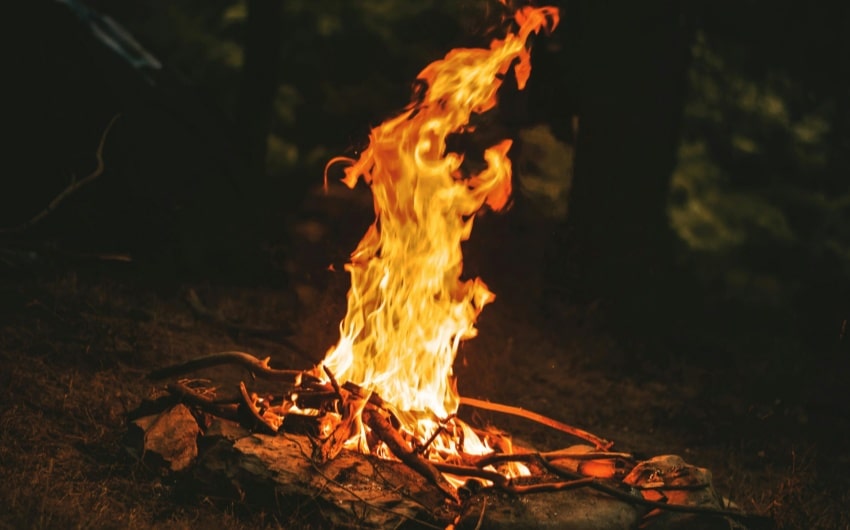How Hot Is a Campfire? Unveiling the Secrets of Flames and Fuel
Campfires have long been a centerpiece of human gathering, offering warmth, light, and a means to cook food. But beyond their cozy ambiance lies a fascinating scientific question: How hot is a campfire?
This article delves into the elements that influence a campfire’s temperature, from the combustion process to the materials fueling the flames. Join us as we explore the intricate dance of fire and physics that determines the heat of a campfire.
The Basics of Campfire Construction
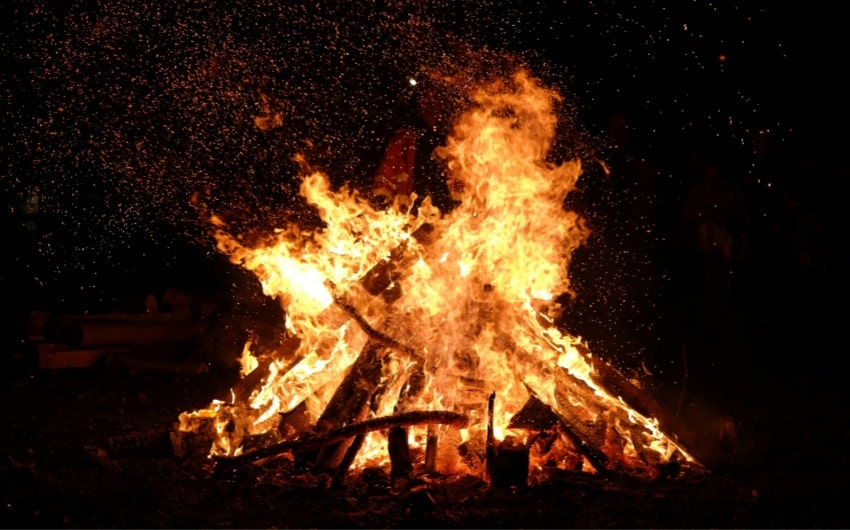
Constructing a campfire effectively is foundational to achieving the desired warmth and longevity of the fire. The construction method not only dictates the initial ease of lighting the fire but also its subsequent maintenance and heat output. Three primary designs are commonly utilized, each with its own benefits and optimal use cases.
1. Teepee
This construction mimics the shape of a traditional teepee, with kindling and smaller sticks arranged in a cone shape around a central point. As the fire catches, larger logs are gradually added to the outside, falling inward as the structure burns.
This design is excellent for heat concentration and efficient air circulation, making it ideal for quick and intense heat generation.
2. Log Cabin
The log cabin layout involves placing logs in a square or rectangle formation, stacking them alternately to create a cabin-like structure. Kindling and smaller, more combustible materials are placed in the center.
This method promotes a steady, slower burn, suitable for consistent heat over a longer period. It’s particularly useful for cooking and maintaining a stable source of warmth.
3. Lean-to
This design involves leaning smaller branches or sticks against a larger log or rock, creating a sheltered space for the kindling. The lean-to is excellent for windy conditions, protecting the initial flames from being extinguished while allowing for sufficient airflow to feed the fire.
Regardless of the structure chosen, the principles of campfire construction remain the same: start small with tinder and kindling to establish a steady flame, then gradually increase the size of the wood added as the fire grows.
Ensuring proper air circulation is crucial; a fire needs oxygen to burn, and the construction method can significantly affect how well air moves through the fire.
The choice of construction method should consider the campfire’s intended use — whether for cooking, warmth, or ambiance — as well as the environmental conditions, such as wind direction and strength. By starting with a solid foundation in campfire construction, one can ensure a safer, more enjoyable, and efficient fire.
The Science of Combustion and Heat

Understanding the science of combustion and heat is essential to grasp how campfires work and why they reach the temperatures they do.
Combustion is a chemical reaction that occurs when fuel (in this case, wood) comes into contact with oxygen, producing heat and light. This process is fundamental to the burning of a campfire and involves several key principles.
1. Combustion Process
The combustion of wood in a campfire is primarily the reaction of cellulose, which is the main component of wood, with oxygen from the air. This reaction releases energy in the form of heat and light, along with byproducts like carbon dioxide and water vapor.
For combustion to begin, the wood must reach its ignition temperature, which is the point at which it generates enough vapor to sustain a reaction with oxygen.
2. Heat Generation
The amount of heat generated by a campfire is directly related to the efficiency of the combustion process. The heat released during combustion is measured in British Thermal Units (BTUs) or joules.
Several factors influence the efficiency of combustion, including the type and dryness of the wood, the amount of oxygen available, and the arrangement of the fuel within the fire.
3. Flame Temperature and Color
The temperature of a campfire flame can vary widely, typically ranging from about 600°C to 800°C (about 1112°F to 1472°F) at its core.
The color of the flame provides a visual cue to its temperature; blue flames indicate a hotter and more efficient combustion process, occurring at higher temperatures, while yellow or orange flames are cooler, indicating less efficient combustion.
4. Heat Transfer
The heat from a campfire is transferred to the surroundings through convection, conduction, and radiation.
Convection circulates heat through the movement of air, conduction transfers heat by direct contact, and radiation sends heat through electromagnetic waves. These mechanisms work together to warm the area around the campfire.
5. Influence of Oxygen
Oxygen is a critical component of combustion. The amount of oxygen available can significantly affect the temperature and efficiency of the fire. More oxygen means a hotter, cleaner burn, as it allows for more complete combustion of the fuel. Campfire construction can influence airflow and thus the amount of oxygen that reaches the fire.
6. Moisture Content
The presence of moisture in wood can impede the combustion process, as energy from the fire is used to evaporate water before the wood can burn. Dry wood combusts more efficiently, producing more heat and less smoke compared to wet or damp wood.
Understanding the science behind combustion and heat not only enhances our appreciation for the campfire but also informs safer and more effective fire-building practices.
By recognizing the factors that influence the combustion process, one can achieve a warmer, more sustainable fire, enhancing the outdoor experience while minimizing environmental impact.
Measuring Campfire Temperature
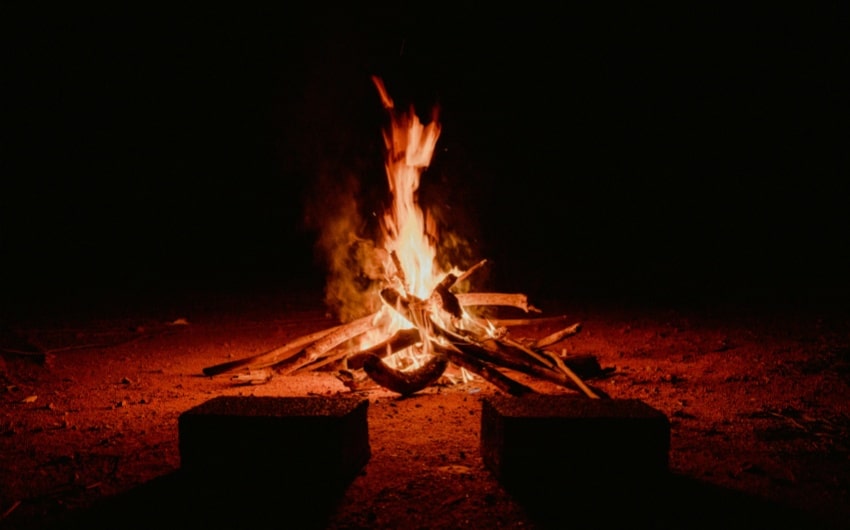
The ability to accurately measure the temperature of a campfire is crucial for a variety of applications, from optimizing cooking temperatures to ensuring safety.
However, given the intense heat and variability of a campfire, direct measurement can be challenging. Several methods and tools can be employed to estimate and measure the heat output of a campfire, each with its own level of accuracy and application.
1. Infrared Thermometers
Infrared (IR) thermometers allow for the non-contact measurement of a campfire’s temperature. By pointing the device at the fire, it detects the infrared radiation emitted by the flames and coals to calculate the temperature.
This method is highly effective for getting quick and safe temperature readings, although it primarily measures surface temperatures and may not accurately reflect the entire fire’s heat output.
2. Thermal Cameras
Thermal cameras provide a more detailed and comprehensive view of a campfire’s temperature distribution. These devices create images based on the infrared radiation emitted by the fire, with different colors representing different temperatures.
Thermal cameras can be particularly useful in identifying hot spots and understanding the heat distribution within a fire, offering insights into the efficiency of combustion and the effectiveness of the fire’s construction.
3. Type-K Thermocouples
For more scientific or precise applications, Type-K thermocouples can be used. These are temperature sensors that can withstand extreme temperatures, making them suitable for inserting directly into a campfire.
They provide accurate temperature readings from within the fire itself, but their use is more complex and requires careful handling to avoid damage and ensure safety.
4. Estimating Based on Wood Type and Flame Color
In the absence of specialized equipment, rough estimates of a campfire’s temperature can be made based on the type of wood being burned and the color of the flame.
Hardwoods generally burn hotter than softwoods, and a blue flame indicates a hotter fire than a yellow or orange flame. While this method is far less precise, it can provide a basic understanding of the fire’s intensity.
5. Safety Considerations
When measuring the temperature of a campfire, safety should be the foremost concern. High temperatures can cause burns and ignite surrounding materials. Always maintain a safe distance from the fire when using measurement tools, and follow the manufacturer’s guidelines for use.
Measuring the temperature of a campfire, whether through advanced tools like infrared thermometers and thermal cameras or through more rudimentary methods, provides valuable information for optimizing the fire’s use and ensuring safety.
By understanding the heat output, individuals can make informed decisions about fire maintenance, cooking, and environmental impact.
7 Factors Affecting Campfire Temperature
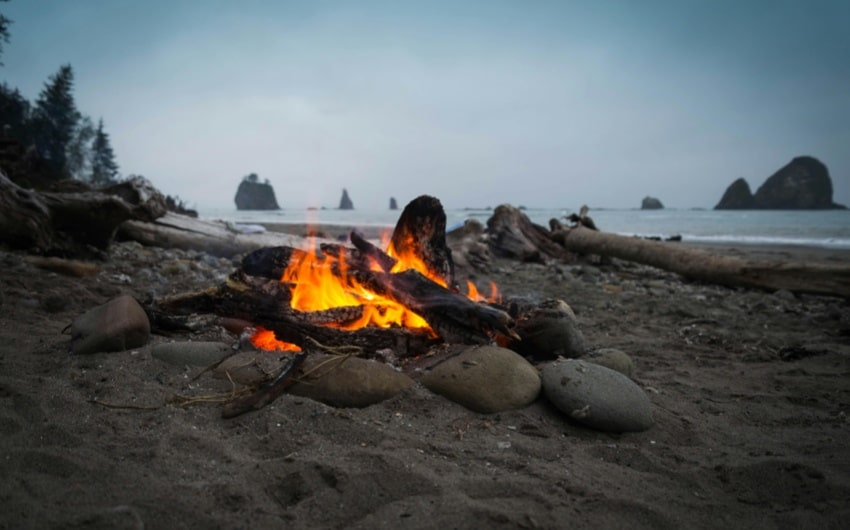
The temperature of a campfire can be influenced by a variety of factors, ranging from the characteristics of the fuel used to environmental conditions. Understanding these factors is essential for managing a campfire effectively, whether for cooking, warmth, or simply enjoying the ambience. Here are some of the key factors that affect campfire temperature:
1. Type of Wood
The species of wood used as fuel has a significant impact on the fire’s temperature. Hardwoods like oak, hickory, and maple burn at higher temperatures and for longer durations than softwoods such as pine or cedar. This is due to their denser structure and higher energy content.
2. Moisture Content
Wood with a high moisture content burns at a lower temperature because energy is consumed to evaporate the water before the wood can ignite and burn effectively. Dry wood, on the other hand, ignites more easily and burns hotter, making it the preferred choice for a high-temperature campfire.
3. Wood Size and Shape
The size and shape of the wood pieces can also influence the campfire’s temperature. Smaller pieces of wood catch fire more easily and can be used to quickly raise the temperature of the fire. However, larger logs are needed to maintain a steady, long-lasting burn, albeit at a potentially lower temperature.
4. Fire Construction
The way a campfire is constructed affects airflow, which in turn influences the fire’s temperature. A loosely stacked fire allows more oxygen to reach the flames, promoting a hotter burn. Conversely, a tightly packed fire restricts airflow, reducing the temperature.
5. Oxygen Availability
Oxygen is a key component of combustion, and its availability directly affects the campfire’s temperature. A fire in an open area with plenty of airflow will burn hotter than one in a confined space or in conditions where air circulation is limited.
6. Environmental Conditions
Weather conditions such as wind, humidity, and temperature can also affect a campfire’s heat. Wind can increase the supply of oxygen and thus the temperature of the fire, while high humidity can dampen the fire’s intensity by increasing the moisture content of the air and fuel.
7. Surrounding Materials
The materials surrounding a campfire, including the ground on which it is built, can absorb heat and affect the temperature. Building a fire on a reflective surface like sand or rock can help retain heat, while a fire built on moist earth may burn cooler due to heat absorption by the ground.
By considering these factors, one can better control the temperature of a campfire, ensuring it meets their needs for cooking, warmth, or ambiance. Adjusting the type of wood used, managing the moisture content of the fuel, and optimizing the fire’s construction and location are all strategies that can enhance the enjoyment and utility of a campfire.
Practical Applications and Safety
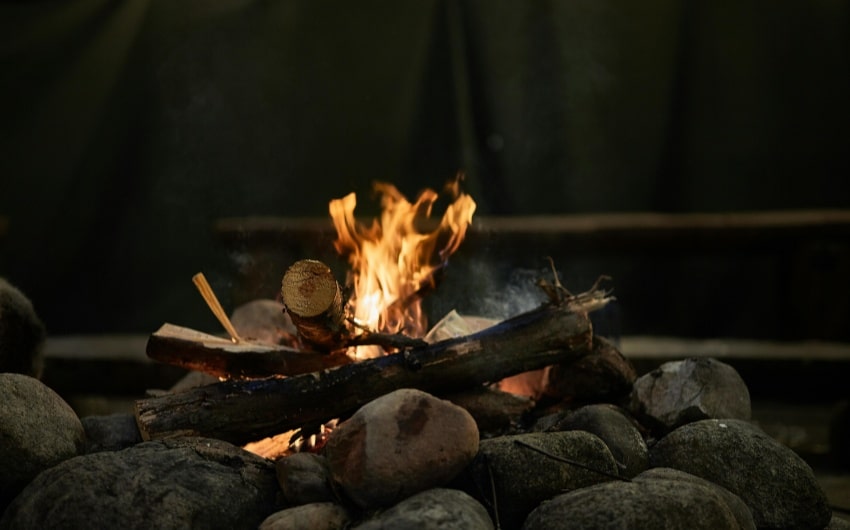
Campfires are more than just a source of warmth and light; they play a central role in outdoor activities, offering a range of practical applications. However, with these benefits come significant safety responsibilities. Understanding both the applications and the safety measures is crucial for anyone engaging in campfire activities.
1. Practical Applications
a. Cooking: Campfires provide a natural means to cook food, from grilling meats to boiling water. Different fire constructions and temperatures are suited for various cooking methods, such as direct grilling over high heat or slow cooking in hot coals.
b. Warmth and Comfort: In cooler climates or during chilly nights, a campfire is an essential source of warmth. It creates a cozy atmosphere, making outdoor spaces more comfortable for socializing and sleeping.
c. Light: Before the advent of portable lights, campfires were the primary light source at night in outdoor settings. Even today, they illuminate the surroundings, extending activities into the evening.
d. Pest Repellent: The smoke from a campfire can help deter insects, including mosquitoes, making outdoor environments more pleasant.
e. Emergency Signal: In survival situations, a campfire can be a crucial signal tool. A large fire or three smaller fires in a triangle are internationally recognized signals for help.
2. Safety Measures
a. Fire Regulations: Always check local fire regulations before starting a campfire. Some areas may have restrictions or require permits, especially during dry seasons when the risk of wildfires is high.
b. Site Selection: Choose a safe, open location for your campfire, away from trees, brush, and other flammable materials. Use existing fire rings or pits when available.
c. Firebreak: Clear a wide area around your campfire site to bare soil to prevent the fire from spreading. This firebreak should be at least 5 feet wide, free of leaves, twigs, and other combustibles.
d. Water and Tools: Always have water, a shovel, and a bucket nearby to manage the fire and extinguish it if necessary. A fire should never be left unattended and must be completely extinguished before leaving the site.
e. Wind Conditions: Be mindful of the wind, which can quickly spread flames. Avoid starting a fire in high wind conditions, and position yourself upwind when igniting the fire to prevent burns.
f. Burn Wisely: Use only wood as fuel. Burning trash or other materials can release harmful chemicals and is often illegal. Also, ensure the wood is dry and collected from the ground rather than cut from living trees.
g. Extinguishing the Fire: When it’s time to extinguish the fire, do so completely. Douse it with water, stir the ashes with a shovel, and apply more water. The fire is not out until the ashes are cool to the touch.
By adhering to these practical applications and safety measures, campfires can be enjoyed responsibly and sustainably, enhancing outdoor experiences while minimizing risks to both individuals and the environment.
Conclusion
The question of how hot is a campfire opens up a world of scientific inquiry and practical knowledge. By understanding the factors that affect a campfire’s temperature, we can enjoy the warmth and utility of fires responsibly and safely.
Whether for cooking, warmth, or simply the pleasure of watching the flames dance, a deeper appreciation for the science of campfires can enhance our outdoor experiences and ensure we leave no trace in our natural surroundings.

